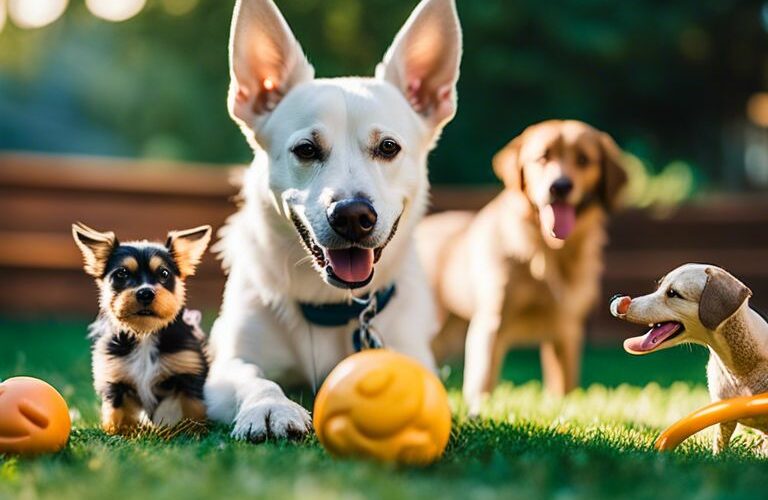Canine companions have an innate instinct to hunt and capture prey, and this natural behavior can be observed through their fondness for toys that emulate prey. These toys, designed to resemble birds, rodents, and other small creatures, stimulate a dog’s hunting instincts and provide mental and physical stimulation. Understanding why dogs are drawn to these types of toys can help pet owners better cater to their dogs’ needs and provide enrichment in their daily routines.
Table of Contents
Key Takeaways:
- Instinctual behavior: Dogs are natural hunters and their instinctual behavior drives them to engage in prey-like activities. Toys that mimic prey trigger this instinct and provide mental stimulation for the dog.
- Physical exercise: Toys that mimic prey often involve interactive play, which allows dogs to release pent-up energy and engage in physical exercise, keeping them fit and healthy.
- Mimics natural behavior: Playing with prey-like toys allows dogs to exhibit natural behaviors such as stalking, pouncing, and shaking, which satisfies their primal instincts.
- Bonding and socialization: Interactive play with prey-like toys can enhance the bond between dogs and their owners, as well as with other dogs during playdates or social interactions.
- Stress relief: Engaging in play with toys that mimic prey can help reduce stress and anxiety in dogs, providing a source of comfort and relaxation.
The Instinctual Basis of Play
Any dog owner knows how much their furry companions love to play, especially with toys that mimic prey. But why do dogs have such a strong instinct to chase and interact with these types of toys? The answer lies in their instinctual basis of play, which is deeply rooted in their evolutionary history.
Predatory Instincts in Dogs
With their origins as hunters and scavengers, dogs have inherited predatory instincts from their ancestors. These instincts drive them to chase, stalk, and capture prey, which is why they are naturally drawn to toys that mimic the movements and sounds of small animals. When dogs engage in play with these toys, they are tapping into their natural instincts and satisfying their urge to hunt and capture prey.
The Evolutionary Role of Play in Survival
Survival in the wild is a constant struggle, and play serves a crucial role in helping young dogs develop the skills they need to survive. Play allows dogs to practice their hunting techniques, sharpen their reflexes, and improve their coordination. Through play, dogs learn valuable lessons about stalking, pouncing, and capturing prey, all of which are essential for their survival in the wild.
Basis on their predatory instincts, dogs’ play behavior with toys that mimic prey is crucial for their development and overall well-being. It helps them hone their natural hunting skills, stay mentally and physically sharp, and satisfy their innate need for play and interaction.
The Attraction to Prey-like Toys
Obviously, dogs have a natural instinct to hunt and chase prey. It’s no wonder they are drawn to toys that mimic the movements and characteristics of their typical prey.
Characteristics of Prey-mimicking Toys
The key to a successful prey-mimicking toy is its ability to simulate the actions and attributes of small animals, such as quick movements, erratic behavior, and even the rustling of feathers or fur. These toys often come in the form of balls, frisbees, or tug-of-war ropes, all designed to captivate a dog’s attention and inspire them to pounce and chase as they would real prey.
Dogs’ Perception of Prey-like Toys
The appeal of prey-like toys lies in a dog’s perception of them as potential prey. The visual and auditory cues of these toys trigger a dog’s hunting instincts, making the play experience more exciting and engaging for them.
Dogs view these toys as a fun and stimulating way to satisfy their natural urge to hunt, without posing any actual danger to real animals. Engaging with prey-like toys allows dogs to express their instinctual behaviors in a safe and controlled environment.
Benefits of Prey-like Toys for Dogs
Despite the abundance of toys available for dogs, prey-like toys offer unique benefits for their mental and physical well-being. These toys are designed to mimic the movements, sounds, and textures of small prey, which taps into dogs’ natural instincts and provides a range of benefits for their overall health and happiness.
Mental Stimulation
Mental stimulation is crucial for dogs’ well-being, and prey-like toys provide an excellent way to keep their minds engaged. The unpredictable movements and sounds of these toys mimic the thrill of the hunt, keeping dogs mentally sharp and preventing boredom. This mental exercise can prevent behavioral issues and improve cognitive function, leading to a happier and more balanced dog.
Physical Exercise
Despite their domestication, dogs still have a natural need for physical activity. Prey-like toys encourage dogs to engage in physical play, leading to benefits such as improved cardiovascular health, muscle tone, and weight management. It also allows dogs to release pent-up energy in a productive and positive way.
It can also help to prevent obesity and joint problems, keeping dogs healthy and fit for a longer, happier life.
Training and Behavioral Development
Toys that mimic prey can be invaluable for dogs’ training and behavioral development. These toys can be used as positive reinforcement tools, helping dogs learn commands and desired behaviors. The thrill of chasing and capturing these toys can also improve a dog’s focus and impulse control, making them more receptive to training overall.
This can lead to a stronger bond between dogs and their owners, as well as a more well-behaved and balanced dog.
Bonding with Owners
With prey-like toys, owners have the opportunity to engage in interactive play with their dogs, creating a stronger bond and deeper connection. This shared activity not only provides physical and mental stimulation for the dogs, but also strengthens the relationship between dogs and their owners. It fosters trust, communication, and a sense of security, leading to a more harmonious and fulfilling relationship.
The use of prey-like toys can be a powerful tool for dogs and their owners to form a deeper and more rewarding bond.
Choosing the Right Toy for Your Dog
To ensure your dog enjoys their playtime to the fullest, it’s important to choose the right toy for them. Do dogs really like squeaky toys only because they sound like a dying baby animal?
Safety Considerations
Safety should be your top priority when choosing toys for your dogs. Always opt for toys that are durable and free from small parts that could pose a choking hazard. Additionally, select toys that are nontoxic and safe for chewing, as some dogs may have a tendency to destroy toys during playtime.
When it comes to stuffed toys, be mindful of the stuffing material. Some dogs may try to ingest the stuffing, which can be dangerous. Look for toys with reinforced seams to prevent tearing, and regularly inspect toys for any signs of wear and tear.
Matching Toys to Your Dog’s Play Style
Dogs have varying play styles, so it’s important to match the right toy to your dog’s preferences. For example, active and energetic dogs may prefer toys that allow them to chase and fetch, while chewing enthusiasts may enjoy durable chew toys to satisfy their natural urge to gnaw.
Your dog’s size and breed should also be taken into consideration when choosing toys. Large breeds may require sturdier toys that can withstand their powerful chewing, while smaller dogs may prefer smaller, softer toys that are easier for them to manipulate and carry.
Why do dogs like toys that mimic prey?
Presently, we can conclude that dogs are drawn to toys that mimic prey due to their natural instincts as predators. Whether it’s the sound of a squeaker or the realistic appearance of a plush animal, these toys tap into a dog’s instincts to hunt and chase. This can provide mental and physical stimulation for the dog, as well as satisfy their natural urge to “hunt” in a controlled environment. Additionally, these toys can also provide comfort and a sense of security for dogs who may have been separated from their litter at a young age, as they can simulate the companionship and playfulness of having a fellow animal to interact with. Understanding a dog’s natural inclinations towards prey-like toys can help owners provide the most engaging and fulfilling play experiences for their furry companions.
FAQ
Q: Why do dogs like toys that mimic prey?
A: Dogs are natural hunters and their instinct to chase and capture prey is deeply ingrained. Toys that mimic prey, such as squeaky toys or plush animals, tap into this instinct and provide mental stimulation and physical exercise for the dog.
Q: Are there any benefits to providing dogs with prey-like toys?
A: Yes, providing dogs with toys that mimic prey can have several benefits. It can help satisfy their natural hunting instincts, relieve boredom, and reduce anxiety. Additionally, playing with prey-like toys can help strengthen the bond between the dog and its owner through interactive play.
Q: Are there any dangers associated with prey-like toys for dogs?
A: While prey-like toys can provide many benefits for dogs, it is important to supervise the dog during play to prevent any potential hazards. It is essential to choose toys that are appropriate for the size and chewing habits of the dog to avoid any choking hazards or ingestion of small parts. Regularly inspecting and replacing damaged toys can also help prevent any accidents.











Add comment